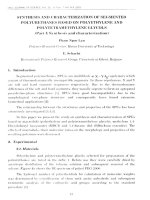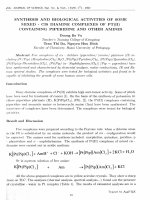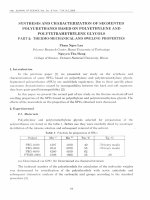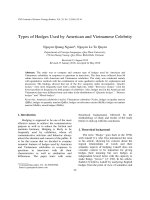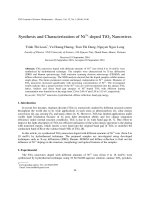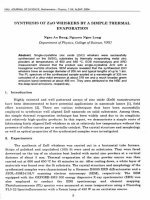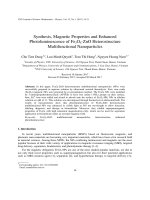DSpace at VNU: Synthesis of vertically aligned carbon nanotubes and diamond films on Cu substrates for use in high-power electronic devices
Bạn đang xem bản rút gọn của tài liệu. Xem và tải ngay bản đầy đủ của tài liệu tại đây (1.14 MB, 13 trang )
188
Int. J. Nanotechnol., Vol. 8, Nos. 3/4/5, 2011
Synthesis of vertically aligned carbon nanotubes and
diamond films on Cu substrates for use in high-power
electronic devices
Nguyen Van Chuc, Ngo Thi Thanh Tam,
Nguyen Van Tu, Phan Ngoc Hong and
Than Xuan Tinh
Laboratory for Carbon Nanomaterials,
Institute of Materials Science,
Vietnam Academy of Science and Technology,
18 Hoang Quoc Viet Road,
Cau Giay District, Hanoi, Vietnam
E-mail:
E-mail:
E-mail:
E-mail:
E-mail:
Tran Tien Dat
College of Technology,
Vietnam National University,
144 Xuan Thuy Road,
Cau Giay District, Hanoi, Vietnam
E-mail:
Phan Ngoc Minh*
Laboratory for Carbon Nanomaterials,
National Key Laboratory of Electronic Materials and Devices,
Institute of Materials Science,
Vietnam Academy of Science and Technology,
18 Hoang Quoc Viet Road,
Cau Giay District, Hanoi, Vietnam
E-mail:
*Corresponding author
Abstract: Currently, most of the vertically aligned carbon nanotubes
(VA-CNTs) and diamond films are mainly synthesised on flat silicon (Si)
substrate. However, to achieve thermal dissipation in high-power electronic
devices (HPEDs), the VA-CNTs and diamond films need to be attached to
thermal dissipation metal substrates (like Cu, Ag, Al, etc.). In this paper,
the fabrication process of the VA-CNTs and diamond films on Cu substrate is
reported in detail. The VA-CNTs were synthesised by the thermal chemical
Copyright © 2011 Inderscience Enterprises Ltd.
Synthesis of vertically aligned carbon nanotubes and diamond films
vapour deposition (CVD) method. The VA-CNTs on Cu substrates were
fabricated by two different methods:
•
directly growing the VA-CNTs using thin catalytic metal layers such as
Fe/Al or Cr/Al as a catalyst
•
transferring the VA-CNTs film that was pre-grown on Si substrate
to Cu substrate.
The diamond films were also directly grown on the Cu substrate by microwave
plasma chemical vapour deposition (MPCVD). The grown VA-CNTs and
diamond films were tested as the thermal dissipation media on a 0.5W InGaN
LED chip. The VA-CNTs and diamond films greatly increased input current of
the LED by more than 500 mA and 350 mA without reaching saturation.
This is higher compared with that of the device packaged using normal
commercial silver thermal paste. Initial experiment results on the LED
demonstrated that the VA-CNTs and diamond films greatly improve the light’s
output power and that they are optimal choices for the thermal dissipation
of HPED.
Keywords: vertically aligned carbon nanotubes; diamond; thermal dissipation;
high-power electronic device.
Reference to this paper should be made as follows: Chuc, N.V., Tam, N.T.T.,
Tu, N.V., Hong, P.N., Tinh, T.X., Dat, T.T. and Minh, P.N. (2011) ‘Synthesis
of vertically aligned carbon nanotubes and diamond films on Cu substrates for
use in high-power electronic devices’, Int. J. Nanotechnol., Vol. 8, Nos. 3/4/5,
pp.188–200.
Biographical notes: Nguyen Van Chuc received a BS from the Hanoi
University of Science, Vietnam National University, Hanoi (VNUH), in 2003
and an MS from the College of Technology, VNUH, in 2006. He is currently
pursuing his PhD in Electronic Materials and Devices at the Institute of
Materials Science, Vietnam Academy of Science and Technology (VAST).
His current interests are physics, technology and the applications of carbon
nanotube materials.
Ngo Thi Thanh Tam received a BS in Electronics from the National
Polytechnic College of Azerbaijan in 1983 and an MS in Physics of
Semiconductors from the Institute of Physics, National Center of Natural
Sciences and Technology of Vietnam, in 1994. She received PhD in Materials
Sciences from the Institute of Materials Sciences, VAST, in 2002. At present,
her research concentrates on the fabrication of carbon nanotubes and their
application. She is a co-author of more than 20 publications, which focus on the
hydrogen-sensing structure of Pt (Pd)/Si diodes, the structural and optical
properties of porous silicon, and the fabrication and application of carbon
nanotubes.
Nguyen Van Tu received a BS from the College of Technology, VNUH, in
2009. He is currently a Researcher in the Laboratory of Carbon Nanomaterials
at the Institute of Materials Science, VAST. His research fields include the
fabrication and application of carbon nanotubes (CNTs).
Phan Ngoc Hong received a BS from the Hanoi University of Science,
VNUH, in 2005 and an MS from the College of Technology, VNUH, in 2009.
He is currently working as a Researcher in the Laboratory of Carbon
Nanomaterials, Institute of Materials Science. He is currently pursuing his PhD
189
190
N.V. Chuc et al.
at the Universite Pierre et Marie Curie, France. His research fields include the
fabrication and application of carbon nanotubes, diamond materials, and nano
photonics.
Than Xuan Tinh received a BS from the Hanoi University of Science, VNUH,
in 2005, and an MS from the College of Technology, VNUH, in 2008. He is a
Researcher in the Laboratory of Carbon Nanomaterials, Institute of Materials
Science. He is currently pursuing his PhD at the University of Montpellier 2,
France. His research fields include the fabrication and application of carbon
nanotubes.
Tran Tien Dat received a BS from the Hanoi University of Science,
VNUH, in 2006. He is currently pursuing his MS in Nano Science
and Technology at the College of Technology, Vietnam National University,
Hanoi. At present, his research focuses on the fabrication and application of
diamond materials.
Phan Ngoc Minh received his BS in Physics from Hanoi University, Vietnam,
in 1991; a PhD in Physics from the Institute of Physics, Vietnam Academy of
Science and Technology (VAST), Hanoi, Vietnam, in 1996; a PhD in
Engineering from Tohoku University, Japan, in 2001. From 2001 to 2004, he
worked as a Post-Doctoral Researcher and then as an Assistant Professor
at the Graduate School of Engineering, Tohoku University, Japan. From
June 2007 to September 2009, he has been a Vice Director of the Institute
of Materials Science and Director of the National Key Laboratory of
Electronic Materials and Devices at the Institute of Materials Science, VAST.
Currently, he is an Associate Professor of the Institute of Materials Science,
VAST and Visiting Lecturer of the College of Technology, Vietnam National
University-Hanoi. His current interests are physics, technology and applications
of nano-structured materials for electronic, photonic and optoelectronic
applications; carbon-based nanomaterials; micro/nano electro mechanical
systems.
1
Introduction
The problem of thermal dissipation materials for use in high-power electronic devices
(HPEDs) such as light emitting diode (LED) chips and laser has attracted special interest
from scientists and technologists. The inner temperature of high-power electronic
devices increases cyclically as a consequence of their own operation. Traditionally,
heat dispersion from the HPED is carried out by passive strategies, which means using
high thermal conductivity metals such as copper (Cu), silver (Ag) and aluminium (Al) as
heat sinks. In order to increase the rate of thermal dissipation and increase the lifetime of
electronic devices, finding new materials with advanced thermal dissipation properties to
replace Cu, Ag, and Al is necessary.
Carbon nanotubes (CNTs), vertically aligned carbon nanotubes (VA-CNTs) and
diamond materials are promising candidates to improve the thermal performance of the
HPED due to their low thermal resistance as well as the ultra-high thermal conductivity.
At room temperature, an individual multi-walled carbon nanotube (MWCNT) and
diamond film have high thermal conductivity of about 600–3000 W/m.K [1,2], and about
2000 W/m.K [3,4], respectively. Meanwhile, the thermal conductivity of traditional high
Synthesis of vertically aligned carbon nanotubes and diamond films
191
thermal conductivity metals is much lower compared with that of the individual
MWCNT and diamond film. The thermal conductivities of Ag, Cu and Al are 419
W/m.K, 380 W/m.K [5,6] and 238 W/m.K [7], respectively.
However, most of the VA-CNTs and diamond films are mainly synthesised on
flat silicon (Si) substrate. Unfortunately, Si is not a good choice in terms of thermal
conductivity. Therefore to achieve thermal dissipation in the HPED, the VA-CNTs and
diamond films need to be attached to thermal dissipation metallic substrates such as Cu,
Ag or Al.
In this paper, the fabrication of the VA-CNTs and diamond films on Cu substrates is
reported in detail. The VA-CNTs on Cu substrates were fabricated by both directly
growing the VA-CNTs on the Cu substrates and transferring the VA-CNTs layers that
were pre-grown on Si substrate onto the Cu substrate. The diamond films were
synthesised on the Cu substrate by microwave plasma chemical vapour deposition
(MPCVD). The light emission performance of the LED packages using the VA-CNTs
and diamond films was tested on the 0.5 W InGaN LED chip. The results indicated that
the light output power of the LED chip was greatly improved with the use of the
VA-CNTs and diamond films as thermal dissipation materials. These initial results show
that the VA-CNTs and diamond materials are optimal choices for thermal dissipation
of HPED.
2
Experimental results and discussions
2.1 Fabrication of VA-CNTs on Cu substrates
2.1.1 Direct growth of VA-CNTs on Cu substrates
To successfully grow the VA-CNTs films, it is necessary to have a high density of
catalytic particles on the surface of a substrate. Al/Fe or Al/Cr catalyst films deposited
onto thin Cu sheets with the purity of 99.9% were used. An Al layer with a thickness of
15 nm was first deposited on the surface of the Cu substrate by thermal evaporation,
and then Fe or Cr layers with thickness levels from 3 nm to 5.5 nm were deposited
by sputtering method at room temperature and a base pressure of about 8 × 10–7 Torr.
Subsequently, the Cu substrates with Al/Fe or Al/Cr catalyst films were placed in a
quartz boat and then inserted into the centre of a quartz tube reactor with a diameter of
2.7 cm housed in a furnace at 400°C. The samples remained at 400°C in air for 10 min.
Then, the furnace was heated to 750°C in Ar gas (300 sccm). The H2 gas (100 sccm) was
introduced to deoxidise the Fe or Cr catalyst for 10 min. The VA-CNTs were grown
at 750°C for 30 min in the mixture of C2H2/H2/Ar with flow rate ratios fixed at
30/100/300 sccm. After finishing the growing process, H2 gas (100 sccm) was maintained
for 10 min at growing temperature. Then, the samples were cooled down to room
temperature in the flow of Ar gas (300 sccm).
Figure 1 shows SEM images of the VA-CNTs films grown on Cu substrates with
thickness of (A) Fe – 4 nm; (B) Cr – 4 nm. We found that the Fe catalytic film with
a thickness ranging from 3 nm to 5.5 nm is suitable for growing VA-CNTs on Cu
substrates. In contrast, on the samples with the Cr thickness of lower than 4 nm,
the CNTs are not aligned (not shown here). Meanwhile, on the samples with the
Cr thickness of higher than 4 nm, the CNTs are aligned (Figure 1(B)). The SEM images
192
N.V. Chuc et al.
(Figure 1) indicate that density of the VA-CNTs on Cu substrate is very high and the
length of the CNTs is in the range of 20–30 µm. Figure 2 shows that the CNTs grown on
the Cu substrate are clean and the diameter of the CNTs is in the range of 15–25 nm.
Figure 1
SEM images of VA-CNTs grown on (A) Fe/Al/Cu substrate with Fe thickness of 4 nm
and (B) Cr/Al/Cu substrate with Cr thickness of 4 nm
Figure 2
High magnification SEM images of CNTs grown on (A) Fe/Al/Cu substrates
and (B) Cr/Al/Cu substrates
2.1.2 Transferring VA-CNTs layer grown on Si/SiO2 substrate to Cu substrate
Besides the method of directly growing the VA-CNTs on Cu substrate as mentioned
above, we developed a technique to transfer the VA-CNTs layer from Si to Cu substrates.
First, we synthesised the VA-CNTs films on the Si/SiO2 substrate. Then, we transferred
the VA-CNTs layer from the Si/SiO2 substrate to the Cu substrate. The VA-CNTs films
were synthesised on the Si/SiO2 substrate by CVD method using Fe3O4 particles as the
catalyst. The Fe3O4 nanoparticles were formed by the co-precipitation reaction of iron
salts. The Fe3O4 particles, which had diameters from 10 to 20 nm, were uniformly
coated on the surface of Si/SiO2 substrate by spin-coating method. The SEM image
(Figure 3(A)) indicated that the Fe3O4 nanoparticles were located on the surface of the
Si/SiO2 substrate with a high density of approximately 1010–1012 cm–2. The AFM image
(Figure 3(B)) showed that the diameters of the Fe3O4 nanoparticles were in the range of
10–20 nm.
Synthesis of vertically aligned carbon nanotubes and diamond films
193
The VA-CNTs were grown on Si/SiO2 substrate at different growing temperatures
using a mixture of N2/H2/C2H2 gases with ratio of 300/100/30 sccm. We found that the
alignment of the CNTs strongly depend on the growth temperature. At a temperature of
lower than 650°C, the CNTs were less well aligned (not shown here). The orientation
of CNTs changed from a random spaghetti-like distribution for CNTs grown at 650°C to
a vertical forest-like alignment for CNTs grown at 750°C. Figure 4(A) shows a typical
SEM image of the CNTs on SiO2/Si substrate grown at 750°C for 30 min. It is clear that
the nanotubes are well aligned and uniform in height. The height of the VA-CNTs
is approximately 15 µm. A typical TEM image (Figure 4(B)) of the CNTs sample
grown for 30 min at 750°C shows that the CNTs are clean with diameters of
approximately 15 nm.
Figure 3
(A) SEM and (B) AFM images of the Fe3O4 nanoparticles on the Si/SiO2 surface
(see online version for colours)
Figure 4
(A) SEM and (B) TEM images of the VA-CNTs grown for 30 min at temperature
of 750°C [1]
Figure 5 is a schematic diagram of the process to transfer the VA-CNTs layer from the
Si/SiO2 substrate to the Cu substrate. The synthesised VA-CNT films were detached from
the Si/SiO2 substrate by directly immersing the sample into distilled water at a
temperature of 60°C with the slow rate of 2~5 mm/s. The process of detaching the
VA-CNTs films from the Si/SiO2 substrate is also reported in detail in [8]. The floating
194
N.V. Chuc et al.
VA-CNTs film was then attached to the silver conductive epoxy coated Cu substrate.
By using this technique, the VA-CNTs were successfully transferred to the Cu substrate.
Figure 5
Schematic view of the transfer of the VA-CNTs layer from Si/SiO2 substrate
to Cu substrate (see online version for colours)
2.2 Fabrication of diamond films on Cu substrates
The process of growing the diamond films on the Cu substrate was carried out using an
AsTeX plasma chemical vapour deposition system with a 1.5 kW microwave source
and vertically confined plasma excited at 2.45 GHz. A substrate holder was made of
molybdenum. The substrate was heated by the plasma using a control heater.
During the deposition, the temperature of the substrate was monitored by a
two-colour pyrometer.
The size of the copper substrates was 25 mm × 25 mm in area and 1 mm in thickness.
The surface of the Cu substrates was polished by mechanical abrasion using sand paper,
and then wet etched in a 40% HF acid solution for 2–5 min. Subsequently, the Cu
substrates were abraded with diamond slurry by ultrasonic treatment for 12 h to create
and enhance the diamond nucleation density. After mounting on the target chamber,
the Cu substrates were exposed to H+ plasma at 900°C for 3 h to remove the residual
surface oxide. For the growth stage, the experimental parameters were the gas pressure
of 25 Torr, the substrate temperature of 700°C, the total gas flow rate of 100 sccm,
the gas flow ratio of CH4/H2 of 1%, the microwave power of 500 W and the deposition
time of 5 h.
Due to the poor adherence between the grown diamond film and the Cu substrate
(called diamond/Cu sample), it was necessary to transfer the synthesised diamond film to
another Cu substrate used as a heat sink. The transfer process of the diamond film was as
follows. First, the good heat-conductive film (3 M thermal bonding film) was adhered
onto the Cu heat sink surface. Then, the diamond/Cu sample was placed on the Cu heat
sink surface so that the diamond film was in contact with the Cu heat sink surface.
We lightly pressed the diamond film/Cu sample into the Cu heat sink surface. Next, the
Cu substrate of the diamond/Cu sample was removed. Finally, to improve the adherence
between the Cu heat sink and diamond film, the whole sample was annealed in air for
1 h at 75°C for polymerisation heat-conductive film. The schematic procedure of the
transfer of the diamond film to the Cu heat sink is shown in Figure 6.
Synthesis of vertically aligned carbon nanotubes and diamond films
Figure 6
195
Schematic view of the transfer of the diamond film to Cu heat sink (see online version
for colours)
The diamond samples were characterised by Raman spectroscopy, X-ray diffraction
(XRD) and scanning electron microscopy (SEM). Raman spectroscopy was used
to characterise the diamond films for sp3– and sp2–bonded carbon content using
17 mW He-Ne laser at the excitation wavelength of 632.8 nm. The X-ray diffraction
patterns from the films were obtained using a Siemens D5000 X-Ray diffractometer and
Cu–KĮ radiation (Ȝ = 1.5406 Å). The surface morphologies of the films were studied
using a field emission scanning electron microscope (Hitachi FESEM S–4800).
Figure 7(A) is a typical SEM image of the diamond film surface deposited for 5 h and
Figure 7(B) is its corresponding cross-section SEM image. Figure 7(A) shows that the
diamond film had a well-defined crystal shape and most of the grains had a well-faceted
pyramidal shape. The thickness of this film is approximately 700 nm (Figure 7(B)).
The growth rate of the diamond film is approximately 140 nm/h.
Figure 7
(A) SEM images of the surface and (B) cross-section of the diamond film deposited for
5 h on Cu substrate
Figure 8(A) is the Raman spectrum of the diamond film. The spectrum contains an
intense diamond peak at around 1332 cm–1 and a typical diamond-like carbon (DLC)
peak at around 1550 cm–1 [9]. Normally, the typical DLC spectrum contains a broad
single peak at around 1550 cm–1 with a ‘shoulder’ at around 1350 cm–1, namely the G and
D peaks, respectively [10]. The G-peak is attributed to the crystalline graphite; the D
peak is attributed to the disordered graphite. In our sample, the sharp peak at 1332 cm–1
is the characteristic line of crystalline diamond and wide enough to overlap with the
D peak at around 1350 cm–1. Hence, there are two peaks in the Raman spectrum: the G
peak at around 1550 cmí1 and the diamond peak at 1332 cm–1. It is clear that the diamond
peak at 1332 cm–1 is extremely sharp. It demonstrates that the film has a good diamond
structure [11].
196
Figure 8
N.V. Chuc et al.
(A) Raman spectrum and (B) X-ray diffraction pattern of the diamond film deposited
for 5 h
Figure 8(B) is the XRD pattern of the diamond film deposited for 5 h at 25 Torr.
The XRD pattern exhibits two peaks at 43.93° and 75.29°, indexed to the diffraction
from (111) and (220) crystal planes of the diamond, respectively [11]. The large
I(111)/I(220) ratio indicates the preferred <111> textured growth of the diamond film.
The Raman spectrum and XRD pattern indicated that the diamond and DLC thin
films have been deposited on the copper substrates by the MPCVD method. They are
polycrystalline diamond films. The result is acceptable because the synthesis of diamond
on copper is a difficult endeavour.
2.3 Application of the VA-CNTs and diamond films for LED chips
The synthesised VA-CNTs and diamond thin films were utilised as heat spreaders to
reduce the local temperature of high-power electronic devices. The LED chip used in this
work was an InGaN on sapphire with an active area; emitting light wavelength and
working power of 0.5 mm × 0.5 mm, 460 nm and 0.5 W, respectively. Figure 9 shows a
schematic view of the LED package using the VA-CNTs or diamond films as thermal
dissipation materials. They were inserted as a heat spreader between the device and the
copper heat sink. The VA-CNTs and diamond films were adhered to the Cu substrate by
good thermal conductive material (Arctic silver 5 M or 3 M thermal bonding film).
It is expected that the diamond heat spreader will reduce the local temperature in
high-power LEDs.
Figure 9
Schematic view of the LED using thermal dispersive VA-CNTs or diamond films
(see online version for colours)
Synthesis of vertically aligned carbon nanotubes and diamond films
197
The SEM images of the VA-CNTs and diamond film on Cu substrate before assembling
the LED chip are shown in Figure 10(A) and 10(B), respectively. Figure 10(C) is a
typical SEM image of the VA-CNTs on Cu substrate after assembling and wiring the
LED chip on the VA-CNTs or diamond/Cu substrate.
Figure 10 SEM images of (A) the VA-CNTs layer; (B) the diamond layer lifted off and pasted on
the Cu substrates; (C) the LED chip adhered to the VA-CNTs or diamond film
The output light power of the LED packages should ideally maintain a linear relationship
with the electrical input current if the heat generated from the LED modules can be
effectively dissipated. However, heat generated by high input power would degrade the
LED optical performance and result in a saturation of output light power. Normally,
for the InGaN LED chip used in this experiment, the light power of the LED packages
using the commercial thermal dissipation material starts to deviate from a linear
relationship with the input current about 300 mA and reaches a peak value at 350 mA.
By using VA-CNTs or diamond films instead of the commercial thermal dissipation
material, the output light power of the LED packages retains a linear profile without
reaching saturation even if the input current is higher than 500 mA and 350 mA,
respectively. Figure 11 shows the light emission from the modified LED/VA-CNTs/Cu
198
N.V. Chuc et al.
operating at 100 mA (A) and 500 mA (B). The packaged LED/diamond film/Cu
operating at 350 mA is shown in Figure 11(C). These results indicated that the VA-CNTs
and diamond films act as an excellent heat spreader layer that rapidly dissipates heat from
the heat source (LED).
Our initial result confirmed that the VA-CNTs and diamond films strongly improve
thermal dissipation property and can be used in high-power electronic devices.
Figure 11 Light emission from the packaged LED operated at an input current of 100 (A), 500 (B)
using the VA-CNTs and 350 mA (C) using diamond film as the thermal dissipation
media (see online version for colours)
Synthesis of vertically aligned carbon nanotubes and diamond films
3
199
Conclusions
The VA-CNTs and diamond films on Cu substrates were successfully synthesised.
An effective method was successfully developed to transfer the VA-CNTs film from the
Si substrate to Cu substrate. The diameter of carbon nanotubes and the thickness of the
vertically aligned carbon nanotube films were in the range of 10–30 nm and 10–30 µm,
respectively. The light performance of the light emitting diode (LED) packages using the
VA-CNTs and diamond films was tested on an InGaN LED chip. The VA-CNTs and
diamond films maintained a linear relationship of the output light power without reaching
saturation for the LED chip of 0.5 W InGaN, compared with the packaged device using
commercial silver thermal paste. The VA-CNTs and diamond films greatly increased
the input LED current, about more than 500 mA and 350 mA, respectively. This result
indicates that the light output power was greatly improved with the use of the VA-CNTs
and diamond films. Initial results from the LED-0.5 W InGaN experiment demonstrated
that the VA-CNTs and diamond films are optimal choices for the thermal dissipation
of HPED.
Acknowledgements
This work is supported by National Basic Research Fund (NAFOSTED, code:
103.03.47.09), the AOARD 104140 Project. A part of the work was done with the help of
the Key Laboratory for Electronic Materials & Devices, IMS.
References and Notes
1
2
3
4
5
6
7
8
9
Choi, T.Y., Poulikakos, D., Tharian, J. and Sennhauser, U. (2005) ‘Measurement of thermal
conductivity of individual multiwalled carbon nanotubes by the 3-omega method’, Appl. Phys.
Lett., Vol. 87, pp.013108-1–013108-3.
Kim, P., Shi, L., Majumdar, A. and McEuen, P.L. (2001) ‘Thermal transport measurements of
individual multiwalled nanotubes’, Phys. Rev. Lett., Vol. 87, pp.215502-1–215502-4.
Graebner, J.E., Jin, S., Kammlott, G.W., Herb, J.A. and Gardinier, C.F. (1992) ‘Unusually
high thermal conductivity in diamond films’, Appl. Phys. Lett., Vol. 60, pp.1576–1578.
Slack, G.A. (1973) ‘Nonmetallic crystals with high thermal conductivity’, J. Phys. Chem.
Solids, Vol. 34, pp.321–335.
CRC Handbook of Chemistry and Physics, 90th edition (Internet version 2010), edited by
D.R. Lide, CRC Press/Taylor and Francis, Boca Raton, FL, Section 12, pp.198–199.
Berver, S., Kwon, Y.K. and Tománek, D. (2000) ‘Unusual high thermal conductivity of
carbon nanotubes’, Phys. Rev. Lett., Vol. 84, No. 20, pp.4613–4616.
Chen, P.H., Lin C.L., Liu, Y.K., Chung, T.Y. and Liu, C.Y. (2008) ‘Diamond heat spreader
layer for high power thin-GaN light emitting diodes’, IEEE Photonics Technol. Lett., Vol. 20,
No. 10, pp.845–847.
Murakami, Y. and Maruyama, S. (2006) ‘Detachment of vertically aligned single-walled
carbon nanotube films from substrates and their re-attachment to arbitrary surfaces’,
Chem. Phys. Lett., Vol. 422, pp.575–580.
Badzian, A.R., Badzian, T., Roy, R., Messier, R. and Spear, K.E. (1988) ‘Crystallization of
diamond crystals and films by microwave assisted CVD (part II)’, Mater. Res. Bull., Vol. 23,
pp.531–548.
200
10
N.V. Chuc et al.
Zhang, S., Zeng, X.T., Xie, H. and Hing, P. (2000) ‘A phenomenological approach for the
ID/IG ratio and sp3 fraction of magnetron sputtered a-C films’, Surf. Coat. Technol., Vol. 123,
pp.256–260.
11 Yang, S., He, Z., Li, Q., Zhu, D. and Gong, J. (2008) ‘Diamond films with preferred
<110> texture by hot filament CVD at low pressure’, Diamond Relat. Mater., Vol. 17,
pp.2075–2079.

